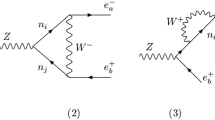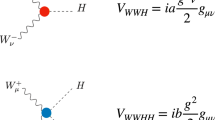Abstract
A left-right symmetric model with two Higgs bi-doublet is shown to be a consistent model for both spontaneous P and CP violation. The flavor changing neutral currents can be suppressed by the mechanism of approximate global U(1) family symmetry. The constraints from neural K meson mass difference Δm K are calculated and it is demonstrated that a right-handed gauge boson W 2 contribution in box-diagrams with mass well below 1 TeV is allowed due to a cancelation caused by a light-charged Higgs boson with a mass range of 150–300 GeV. The W 2 contribution to ε K can be suppressed from an appropriate choice of additional CP phases appearing in the right-handed Cabbibo-Kobayashi-Maskawa matrix. The model is also found to be fully consistent with B 0 mass difference Δm B and the mixing induced CP violation sin2β J/ Ψ, which is usually difficult for the model with only one Higgs bi-doublet. The new physics beyond the standard model can be directly searched at the colliders LHC and ILC.
Similar content being viewed by others
References
Lee T D, Yang C N. Question of parity conservation in weak interactions. Phys Rev, 1956, 104: 254
Wu C S, Ambler E, Hayward R W, et al. Experimental test of parity conservation in beta decay. Phys Rev, 1957, 105: 1413
Christenson J H, Cronin J W, Fitch V L, et al. Evidence for the 2 pi decay of the K(2)0 meson. Phys Rev Lett, 1964, 13: 138
Glashow S L. Partial symmetries of weak interactions. Nucl Phys, 1961, 22: 579
Weinberg S. A model of leptons. Phys Rev Lett, 1967, 19: 1264
Salam A. In: Svartholm N, ed. Proceedings of the Eight Nobel Symposium. Stockholm: Almqvist and Wikell, 1968
Kobayashi M, Maskawa T. CP violation in the renormalizable theory of weak interaction. Prog Theor Phys, 1973, 49: 652
Wu Y L. A new prediction for direct CP violation epsilon’/epsilon and Delta(I) = ½ rule. Phys Rev D, 2001, 64: 016001
Bertolini S. Theory Status of ε’/ε. Frascati Phys Ser, 2002, 28: 275–290
Batley J R, et al. [NA48 Collaboration]. A precision measurement of direct CP violation in the decay of neutral kaons into two pions. Phys Lett B, 2002, 544: 97
Alavi-Harati A, et al. [KTeV Collaboration]. Measurements of direct CP violation, CPT symmetry, and other parameters in the neutral kaon system. Phys Rev D, 2003, 67: 012005 [Erratum-ibid. D, 2004, 70: 079904]
Wu Y L, Zhou Y F. Implications of charmless B decays with large direct CP violation. Phys Rev D, 2005, 71: 021701
Wu Y L, Zhou Y F. Charmless decays B→pi pi, pi K and K K in broken SU(3) symmetry. Phys Rev D, 2005, 72: 034037
Wu Y L, Zhou Y F, Zhuang C. Implications of new data in charmless B decays. Phys Rev D, 2006, 74: 094007
Abe K, et al. [Belle Collaboration]. Observation of large CP violation and evidence for direct CP violation in B 0→pi + pi-decays. Phys Rev Lett, 2004, 93: 021601
Aubert B, et al. [BaBar Collaboration]. Observation of direct CP violation in B 0→K +π−. decays. Phys Rev Lett, 2004, 93: 131801
Lee T D. A theory of spontaneous T violation. Phys Rev D, 1973, 8: 1226
Lee T D. CP nonconservation and spontaneous symmetry breaking. Phys Rept, 1974, 9: 143
Weinberg S. Phys Rev Lett, 1976, 37: 657
Hall L J, Weinberg S. Flavor changing scalar interactions. Phys Rev D, 1993, 48: 979
Wu Y L, Wolfenstein L. Sources of CP violation in the two Higgs doublet model. Phys Rev Lett, 1994, 73: 1762
Wu Y L. hep-ph/9404241, 1994; In: Seestrom S J, ed. Proceedings of the 5th Conference on the Intersections of Particle and Nuclear Physics, St. Petersburg, FL. New York: AIP, 1995. 338, hep-ph/9406306
Wolfenstein L, Wu Y L. CP violation in the decay b→s gamma in the two Higgs doublet model. Phys Rev Lett, 1994, 73: 2809
Wu Y L. Probing new physics from CP violation in radiative B decays. Chin Phys Lett, 1999, 16: 339
Wu Y L, Zhou Y F. F0 anti-F0 mixing and CP violation in the general two Higgs doublet model. Phys Rev D, 2000, 61: 096001
Wu Y L, Zhou Y F. Muon anomalous magnetic moment in the standard model with two Higgs doublets. Phys Rev D, 2001, 64: 115018
Wu Y L, Zhuang C. Exclusive B→P V decays and CP violation in the general two-Higgs-doublet model. Phys Rev D, 2007, 75: 115006
Pati J C, Salam A. Lepton number as the fourth color. Phys Rev D, 1974, 10: 275 [Erratum-ibid. D, 1975, 11: 703]
Mohapatra R N, Pati J C. Left-right gauge symmetry and an isoconjugate model of CP violation. Phys Rev D, 1975, 11: 566
Senjanovic G, Mohapatra R N. Exact left-right symmetry and spontaneous violation of parity. Phys Rev D, 1975, 12: 1502
Chang D. A minimal model of spontaneous CP violation with the gauge group SU(2)-L × SU(2)-R × U(1)-(B-L). Nucl Phys B, 1983, 214: 435
Frere J M, Galand J, Le Yaouanc A, et al. K0 anti-K0 in the SU(2)-L × SU(2)-R × U(1) model of CP violation. Phys Rev D, 1992, 46: 337
Barenboim G, Bernabeu J, Raidal M. Spontaneous CP-violation in the left-right model and the kaon system. Nucl Phys B, 1996, 478: 527
Ball P, Frere J M, Matias J. Anatomy of mixing-induced CP asymmetries in left-right-symmetric models with spontaneous CP violation. Nucl Phys B, 2000, 572: 3
Pospelov M E. FCNC in left-right symmetric theories and constraints on the right-handed scale. Phys Rev D, 1997, 56: 259
Deshpande N G, Gunion J F, Kayser B, et al. Left-right symmetric electroweak models with triplet Higgs. Phys Rev D, 1991, 44: 837
Barenboim G, Gorbahn M, Nierste U, et al. Higgs sector of the minimal left-right symmetric model. Phys Rev D, 2002, 65: 095003
Langacker P, Uma Sankar S. Bounds on the mass of W(R) and the W(L)-W(R) mixing angle xi in general SU(2)-L × SU(2)-R × U(1) models. Phys Rev D, 1989, 40: 1569
Barenboim G, Bernabeu J, Prades J, et al. Constraints on the W(R) mass and CP-violation in left-right models. Phys Rev D, 1997, 55: 4213
Zhang Y, An H, Ji X, et al. Right-handed quark mixings in minimal left-right symmetric model with general CP violation. Phys Rev D, 2007, 76: 091301
Lee T D, Yang C N. Question of parity conservation in weak interactions. Phys Rev, 1956, 104: 254
Kobzarev L, Okun L, Pomeranchuk I, et al. Nucl Phys, 1966, 3: 837
Wu Y L. Maximally symmetric minimal unification model SO(32) with three families in ten dimensional space-time. Mod Phys Lett, A, 2007, 22: 259
Wu Y L. Stability of proton and maximally symmetric minimal unification model for basic forces and building blocks of matter. Sci China Ser G-Phys Mech Astron, 2007, 50(3): 303–310
Branco G C, Lavoura L. Natural CP breaking in left-right symmetric theories. Phys Lett B, 1985, 165: 327
Akeroyd A G, Aoki M, Okada M. Lepton flavour violating tau decays in the left-right symmetric model. Phys Rev D, 2007, 76: 013004
Cheng T P, Sher M. Mass matrix ansatz and flavor nonconservation in models with multiple Higgs doublets. Phys Rev D, 1987, 35: 3484
Inami T, Lim C S. Effects of superheavy quarks and leptons in low-energy weak processes K(L)→Mu Anti-Mu, K+→Pi+Neutrino Anti-Neutrino and K0→Anti-K0. Prog Theor Phys, 1981, 65: 297
Herrlich S, Nierste U. The complete |ΔS| = 2 Hamiltonian in the next-to-leading order. Nucl Phys B, 1996, 476: 27
Lellouch L. Light hadron weak matrix elements. Nucl Phys Proc Suppl, 2001, 94: 142
Beall G, Bander M, Soni M. Constraint on the mass scale of a left-right symmetric electroweak theory from the K(L) K(S) mass difference. Phys Rev Lett, 1982, 48: 848
Mohapatra R N, Senjanovic G, Tran M D. Strangeness changing processes and the limit on the right-handed gauge boson mass. Phys Rev D, 1983, 28: 546
Gilman F J, Reno M H. Restrictions from the neutral k and b meson systems on left-right symmetric gauge theories. Phys Rev D, 1984, 29: 937
Chang D, Basecq J, Li L F, et al. Comment on the K(L) K(S) mass difference in left-right model. Phys Rev D, 1984, 30: 1601
Hou W S, Soni A. Gauge invariance of the K(L) K(S) mass difference in left-right symmetric model. Phys Rev D, 1985, 32: 163
Basecq J, Li L F, Pal P B. Gauge invariant calculation of the K(L) K(S) mass difference in the left-right model. Phys Rev D, 1985, 32: 175
Ecker G, Grimus W. CP violation and left-right symmetry. Nucl Phys B, 1985, 258: 328
Sahoo S, Maharana L, Roul A, et al. The masses of W(R) triplet Higgs, and Z-prime bosons in the left-right symmetric model. Int J Mod Phys A, 2005, 20: 2625
Abbott L F, Sikivie P, Wise M B. Constraints on charged Higgs couplings. Phys Rev D, 1980, 21: 1393
Charles J, et al. [CKMfitter Group]. CP violation and the CKM matrix: Assessing the impact of the asymmetric B factories. Eur Phys J C, 2005, 41: 1. Updated results may be found on the website: http://ckmfitter.in2p3.fr/
Evans H G. [CDF Collaboration]. Bs physics at CDF and D0. arXiv:0705.4598 [hep-ex]
Author information
Authors and Affiliations
Corresponding author
Additional information
Supported by the National Natural Science Foundation of China (NSFC) (Grant Nos. 10475105 and 10491306) and the Key Project of Chinese Academy of Sciences (CAS)
Rights and permissions
About this article
Cite this article
Wu, Y., Zhou, Y. Two Higgs bi-doublet left-right model with spontaneous P and CP violation. Sci. China Ser. G-Phys. Mech. Astron. 51, 1808–1825 (2008). https://doi.org/10.1007/s11433-008-0193-4
Received:
Accepted:
Published:
Issue Date:
DOI: https://doi.org/10.1007/s11433-008-0193-4




